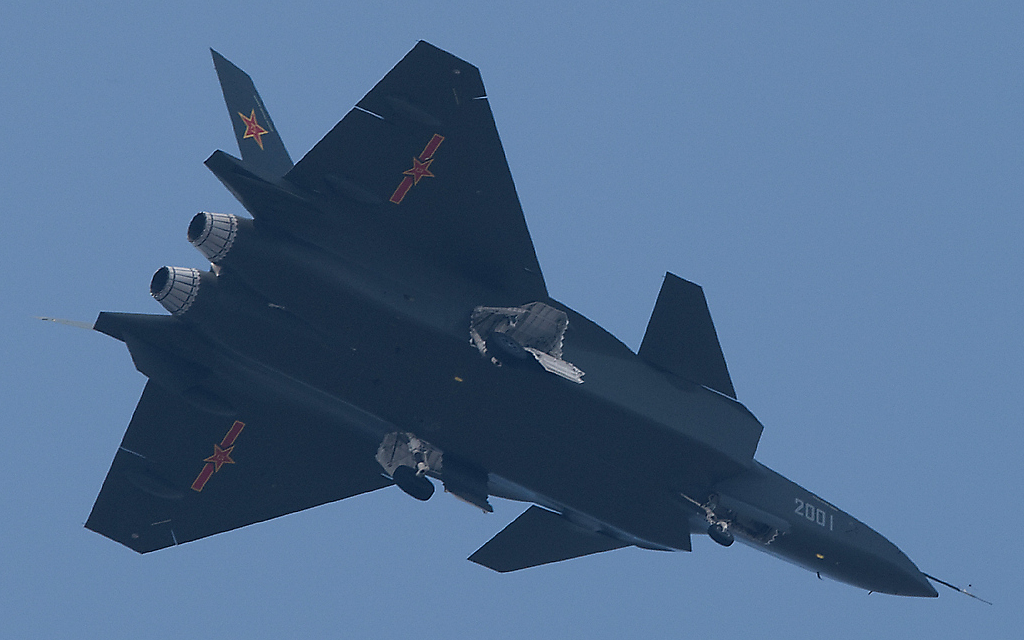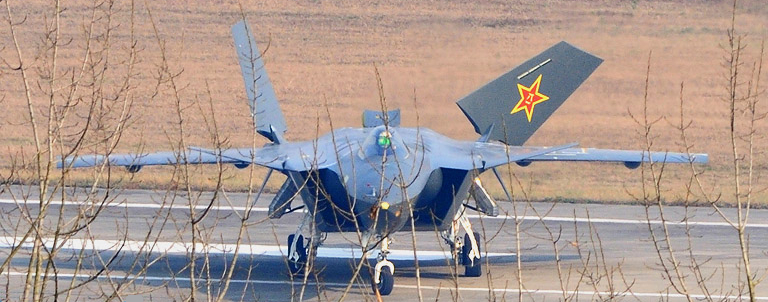The Strategic Impact of China's J-XX [J-20] Stealth Fighter
Air Power Australia - Australia's Independent Defence Think Tank
Air Power Australia NOTAM
9th January, 2011
Imagery Updates 12th, 15th January, 2011
Dr Carlo Kopp, SMAIAA, SMIEEE, PEng,
Head of Capability Analysis, Air Power Australia

Ventral view of Chengdu prototype during January 11th first flight (Chinese Internet).

Chengdu J-XX [J-20] Stealth Fighter Prototype
A Preliminary Assessment
Technical Report APA-TR-2011-0101
The emergence of China's new J-XX [J-20] stealth fighter will have a profound strategic impact, for both the United States and its numerous Pacific Rim allies. There can be no doubt that it is proof positive of the absolute and complete failure of the current OSD driven plan for recapitalisation of the United States tactical fighter fleet, and the fleets of its allies.
Like the Russian T-50 PAK-FA, the J-XX [J-20] is a “game changer” in the sense that the large scale deployment of operational production examples of these aircraft invalidates all of the key assumptions central to United States and allied air power and force structure planning and development, since the early 1990si.
Whether the J-XX [J-20] is a proof of concept demonstrator, or a prototype for a volume production combat type, what the design demonstrates is that Chinese engineers have mastered advanced stealth shaping techniques. The design displays repeated application of United States developed shaping design rules used previously in the F-22 Raptor design, and in some portions of the F-35 Joint Strike Fighter design. An observer unfamiliar with the background of the J-XX [J-20] could be forgiven for mistaking the type for a Lockheed-Martin developed productii.
The accuracy with which the Chengdu engineers replicated key shaping features could be explained by their reverse engineering the design rules from high resolution imagery of US aircraft. However, it also begs some very good questions as to whether this engineering was directly or indirectly aided by less overt means. Exploitation of engineering data acquired by the alleged penetration of United States contractor computer networks would provide equally good or better technical resultsiii.
Airframe shaping is absolutely critical in stealth design, and determines the bounds on the achievable Radar Cross Section performance of any design. If shaping is done poorly, the aft and lower fuselage design of the F-35 being a cardinal example, no amount of radar absorbent material or coating compatible with the weight and volume needs of fighter design will overcome the resulting performance problems. Conversely, if shaping is done right, the cardinal example being the B-2A Spirit, then progressive upgrades of the radar absorbent materials and/or coatings over the life of the design can be used to further improve its stealthiv.
By cleverly exploiting contemporary United States developed stealth fighter shaping design rules, Chengdu engineers were able to rapidly get an excellent basic shaping design with a minimum of risk and cost, and significant long term stealth performance growth potential, as Chinese absorbent material and coating, frequency selective radome, low signature antenna and engine nozzle technology mature over time. A derivative of the J-XX [J-20] built in 2025 would thus have a much lower radar signature than a 2015 build of the same airframe.
The Capability Potential of the J-XX [J-20] Stealth Fighter
While the introduction of robust stealth shaping is an unprecedented design feature for an indigenous Chinese fighter, another first is an airframe evidently designed for efficient supersonic cruise at high altitudes – the delta-canard configuration is not unlike that adopted by the Russians in the cancelled supercruising MiG MFI design.
Supersonic cruise not only kinematically defeats most legacy fighters and Surface to Air Missiles, but confers additional launch range to Air-Air Missiles and smart bombs, provides an energy advantage when merging into close combat, and in a larger design like the J-XX [J-20], yields important productivity gains due to the ability to supercruise to and from targets. The latter can in many circumstances double the effective sortie rate of a bombervvi.
In terms of gross sizing the J-XX [J-20] most closely resembles the smaller configurations proposed for the FB-22A “theatre bomber”, which was to be a dedicated bomber and ISR airframe, intended to supercruise to targets at combat radii in excess of 1,000 nautical miles, a niche occupied by the TAC/SAC GD F/FB-111 family of aircraft during the Cold War. Claims that the Chengdu design is a “Sino-F-22A” make little sense, if the latter were true the aircraft would be considerably smaller. Unlike the FB-22 proposals, the J-XX [J-20] is clearly intended for air combat and using a canard-delta configuration will provide both efficient supersonic cruise, and good supersonic and transonic manoeuvre performance if fitted with engines of sufficient thrust ratingvii.
In technological strategy terms the combination of stealth and supercruise yields high lethality and survivability, supercruise yields high per-sortie productivity, and the sizing and thus combat radius of the airframe provide a basic design with the flexibility to be used effectively across the spectrum of roles covered by the Cold War design F/FB-111 and proposed FB-22 families of aircraft. The canard-delta airframe configuration if fully exploited yields sufficient agility to serve effectively in the spectrum of roles covered by the F-15C and F-22A.
Any notion that an F-35 Joint Strike Fighter or F/A-18E/F Super Hornet will be capable of competing against this Chengdu design in air combat, let alone penetrate airspace defended by this fighter, would be simply absurd. The F-35 Joint Strike Fighter and F/A-18E/F Super Hornet are both aerodynamically and kinematically quite inferior to the as presented J-XX/J-20 design, and even the shape based VLO capability in the J-XX/J-20, as presented, will effectively neutralise any sensor advantage either type might possess against earlier Russian and Chinese fighter designs.
Air Power Australia - Australia's Independent Defence Think Tank
Air Power Australia NOTAM
9th January, 2011
Imagery Updates 12th, 15th January, 2011
Dr Carlo Kopp, SMAIAA, SMIEEE, PEng,
Head of Capability Analysis, Air Power Australia

Ventral view of Chengdu prototype during January 11th first flight (Chinese Internet).

Chengdu J-XX [J-20] Stealth Fighter Prototype
A Preliminary Assessment
Technical Report APA-TR-2011-0101
The emergence of China's new J-XX [J-20] stealth fighter will have a profound strategic impact, for both the United States and its numerous Pacific Rim allies. There can be no doubt that it is proof positive of the absolute and complete failure of the current OSD driven plan for recapitalisation of the United States tactical fighter fleet, and the fleets of its allies.
Like the Russian T-50 PAK-FA, the J-XX [J-20] is a “game changer” in the sense that the large scale deployment of operational production examples of these aircraft invalidates all of the key assumptions central to United States and allied air power and force structure planning and development, since the early 1990si.
Whether the J-XX [J-20] is a proof of concept demonstrator, or a prototype for a volume production combat type, what the design demonstrates is that Chinese engineers have mastered advanced stealth shaping techniques. The design displays repeated application of United States developed shaping design rules used previously in the F-22 Raptor design, and in some portions of the F-35 Joint Strike Fighter design. An observer unfamiliar with the background of the J-XX [J-20] could be forgiven for mistaking the type for a Lockheed-Martin developed productii.
The accuracy with which the Chengdu engineers replicated key shaping features could be explained by their reverse engineering the design rules from high resolution imagery of US aircraft. However, it also begs some very good questions as to whether this engineering was directly or indirectly aided by less overt means. Exploitation of engineering data acquired by the alleged penetration of United States contractor computer networks would provide equally good or better technical resultsiii.
Airframe shaping is absolutely critical in stealth design, and determines the bounds on the achievable Radar Cross Section performance of any design. If shaping is done poorly, the aft and lower fuselage design of the F-35 being a cardinal example, no amount of radar absorbent material or coating compatible with the weight and volume needs of fighter design will overcome the resulting performance problems. Conversely, if shaping is done right, the cardinal example being the B-2A Spirit, then progressive upgrades of the radar absorbent materials and/or coatings over the life of the design can be used to further improve its stealthiv.
By cleverly exploiting contemporary United States developed stealth fighter shaping design rules, Chengdu engineers were able to rapidly get an excellent basic shaping design with a minimum of risk and cost, and significant long term stealth performance growth potential, as Chinese absorbent material and coating, frequency selective radome, low signature antenna and engine nozzle technology mature over time. A derivative of the J-XX [J-20] built in 2025 would thus have a much lower radar signature than a 2015 build of the same airframe.
The Capability Potential of the J-XX [J-20] Stealth Fighter
While the introduction of robust stealth shaping is an unprecedented design feature for an indigenous Chinese fighter, another first is an airframe evidently designed for efficient supersonic cruise at high altitudes – the delta-canard configuration is not unlike that adopted by the Russians in the cancelled supercruising MiG MFI design.
Supersonic cruise not only kinematically defeats most legacy fighters and Surface to Air Missiles, but confers additional launch range to Air-Air Missiles and smart bombs, provides an energy advantage when merging into close combat, and in a larger design like the J-XX [J-20], yields important productivity gains due to the ability to supercruise to and from targets. The latter can in many circumstances double the effective sortie rate of a bombervvi.
In terms of gross sizing the J-XX [J-20] most closely resembles the smaller configurations proposed for the FB-22A “theatre bomber”, which was to be a dedicated bomber and ISR airframe, intended to supercruise to targets at combat radii in excess of 1,000 nautical miles, a niche occupied by the TAC/SAC GD F/FB-111 family of aircraft during the Cold War. Claims that the Chengdu design is a “Sino-F-22A” make little sense, if the latter were true the aircraft would be considerably smaller. Unlike the FB-22 proposals, the J-XX [J-20] is clearly intended for air combat and using a canard-delta configuration will provide both efficient supersonic cruise, and good supersonic and transonic manoeuvre performance if fitted with engines of sufficient thrust ratingvii.
In technological strategy terms the combination of stealth and supercruise yields high lethality and survivability, supercruise yields high per-sortie productivity, and the sizing and thus combat radius of the airframe provide a basic design with the flexibility to be used effectively across the spectrum of roles covered by the Cold War design F/FB-111 and proposed FB-22 families of aircraft. The canard-delta airframe configuration if fully exploited yields sufficient agility to serve effectively in the spectrum of roles covered by the F-15C and F-22A.
Any notion that an F-35 Joint Strike Fighter or F/A-18E/F Super Hornet will be capable of competing against this Chengdu design in air combat, let alone penetrate airspace defended by this fighter, would be simply absurd. The F-35 Joint Strike Fighter and F/A-18E/F Super Hornet are both aerodynamically and kinematically quite inferior to the as presented J-XX/J-20 design, and even the shape based VLO capability in the J-XX/J-20, as presented, will effectively neutralise any sensor advantage either type might possess against earlier Russian and Chinese fighter designs.




Comment